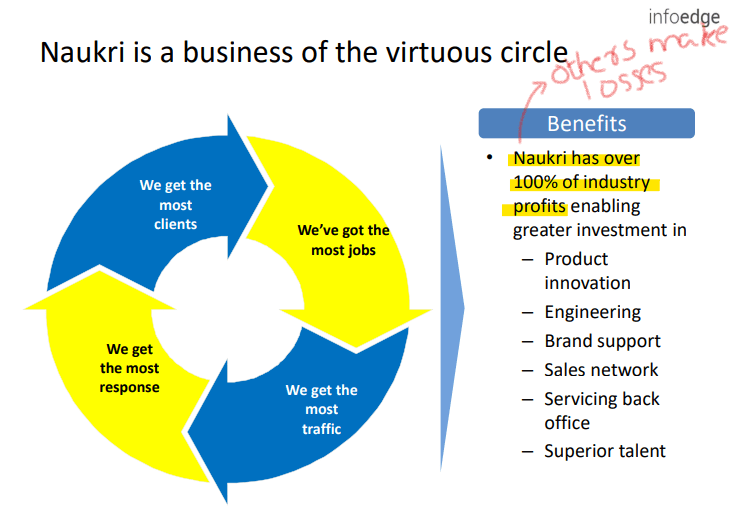Let me start with a few disclaimers:
- TCS is a great company and one of the gems of the India story. I have nothing but respect for it. I am using TCS as an example to illustrate Extremistan – Mediocristan.
- No positions in any of the companies mentioned below.
—
Wealth is not what we associate with taxi drivers. But suppose, I asked you to find the wealthiest taxi driver in your town and let’s call him A. And then we find the second wealthiest taxi driver in your town. Let’s call her B.
Do you think A can be 100 times or even 10 times wealthier than B? Why is that unlikely to happen?
Taxi driving as a profession converts time into money. So for A to earn 10 times more than B, A needs to drive 10 times more the number of hours than B. But A does not have a monopoly over the hours. Time that is available for A to drive is available for B to drive as well. A does not have a monopoly over customers either. A can service only one customer and therefore when A is engaged the market is open to other taxis, including B.
So A neither has a monopoly over the raw materials (time) nor the customers. And hence, A can never aspire to cornering 10 X more business than B. And therefore the wealthiest taxi driver A is unlikely to be 10 times better off than the next wealthiest taxi driver B.
At this time, you may ask what business has a 100% control over the raw materials? IRCTC is one such. It is the only business that has access to the inventory of the railways. You may use other website to book train tickets, but those websites in turn use IRCTC at the back end to book your ticket.
And what businesses has access to 100% of the customers? I don’t have a perfect answer, yet. So bear with this crude example. iTunes is the only gateway to reach 100% of Apple customers. Google play store is the only gateway to reach 100% of Android (Google) customers. So between the 2 of them, you can reach 100% of all smartphone customers.
Unlike IRCTC, iTunes or Playstore, the taxi driver A has no monopoly over the raw materials or the customers.
—
Now, think of Naukri.com, India’s leading online job search portal. Naukri claims to have 80% of the market share. The next biggest guy has about 8% market share. So that makes Naukri 10 X as big as the next biggest guy!

How is that possible?
Unlike the taxi driving profession, Naukri does not convert time to money. No, sir. You could think of Naukri as a classifieds portal. The recruiters post job openings; the job seekers look for job openings and contact recruiters. Alternatively, the recruiters can search for job seekers too. More recruiters are drawn to a platform where they are likely to find job seekers and more job seekers are drawn to a platform where they are likely to find recruiters. This is network effects.
Btw, look how modest Naukri is while explaining it’s business model 🙂

But more interestingly, the heavy lifting of matching recruiters (job) with job seekers is done by algorithms. Not by employees. And unlike a taxi which once engaged by a customer becomes unavailable to other customers, the same algorithm can serve multiple recruiters and job seekers at the same time!
If there is a sudden surge of 10 X customers, the taxi can still service only one customer at a time. But if there is a sudden surge of 10 X more recruiters, the algorithm can still service all of them*. So even if lady luck were to smile, the taxi driver A has no way of capturing the upside or the bounties. On the other hand, Naukri finds the mass recruitment frenzy to it’s advantage and can therefore capture the upside.
We saw a sharp upswing in job seeker metrics as well on the platform. New CV registrations per day stood at 16,000 per day, a growth of 25% compared to Q4 of last year.
Naukri, Q1 FY 22 earnings call
Last year, I had written a blog on Extremistan and Mediocristan. Extremistan is where extreme results are possible. One winner takes away all the market share and profit share, like Naukri. And Mediocristan is where there can be several big players but no one can corner all the profits of the industry, like our friends A and B. So in general, the richest taxi driver is going to be only marginally wealthier than the next richest driver but almost never like 10X.
What I have also tended to realize is that businesses that depend on limited resources as part of it’s business model tend to operate in Mediocristan. For example:
- Convert time to money (Taxi drivers, Barbers, Dentists, IT Services, Consulting)
- Convert real estate to money (hotels, airlines, commercial buildings, theme parks)
- Operate inventory that perishes with time (hotels, airlines, resorts)
- Convert human horsepower to money (textile companies, iron smiths)
Because businesses in Mediocristan have one or the other kind of limitations (like time, human availability, human energy) their upsides also tend to be capped. Or in other words, businesses in Mediocristan have supply side constraints. Even if there was a large demand, their supply has an upper limit. For an airline, the number of seats is the limiting factor. For Taxi drivers, it is the number of hours. For textile companies it is the trained manpower. For co-working spaces it is the number of seats available.
On the other hand, businesses in Extremistan:
- Do not convert time to money. Time is limited and therefore any business that converts time to money is unlikely to be in Extremistan.
- Do not depend on human effort. Like time, human energy is also limited. In Extremistan, the hard work is usually done by technology. When I say technology, I like to think more in terms of algorithms and not robots. The technology can serve many, many customers at the same time. Once built, the technology and the algorithms can be reused again and again without any wear and tear. Contrast that to a piece of machinery that wears with time and usage. And it can do only 1 job at a time. The algorithm costs a lot to build but very little to maintain. Like a toll road.
- Can serve an infinite number of customers (or say 10 X the number of customers). Businesses in Extremistan don’t have supply side constraints like time available or number of billable employees or availability of manpower. They may have demand side constraints, like finding enough customers but not on the supply side. What does it take for Microsoft to produce one more copy of MS Office? Just willingness. And they have abundance of that. But can Indigo serve 10 X its current passengers? No.
And therefore, only in Extremistan can you find a company that has 80% or 90% or 99% market share.
So why can’t TCS have 99% of the market share?
- TCS operates in Mediocristan, not Extremistan.
- TCS converts human energy and time to money. TCS’s average revenue per employee per year is in the range of Rs 30 to 35 L. Therefore for TCS to increase revenues, it will have to increase it’s employee count. More employees means more billable hours and more billable hours (supply) translates to more revenues.The problem with converting human energy and time to money is that both are in limited supply and therefore TCS has supply side constraints as it has only a limited supply of billable hours. Even if TCS had access to 99% of the customers, it won’t be able to meet that demand unless it has access to 99% of the employees of the IT Services industry.
- Each TCS employee can serve only 1 customer at a time. So if hypothetically they got an order for $ 150 B, which is about 10 X their current revenue, they will need 10 X the employees or about 40 L employees that are ready and available to be billed. Not going to happen in a short span of time.
—
As one of my friends said: some books should have been a blog and some blogs a tweet and some tweets shouldn’t have existed. While I am in the mood to write a book, I’ll stop with just a blog.
-Cheers!
*Yes, servers do crash but Naukri can at least theoretically increase processing capacity but impossible for the taxi driver to create replicas of himself to service the demand.

Well written Vikas. Love reading your articles. Will spread the word.
LikeLike
Thank you Rangin!
LikeLike